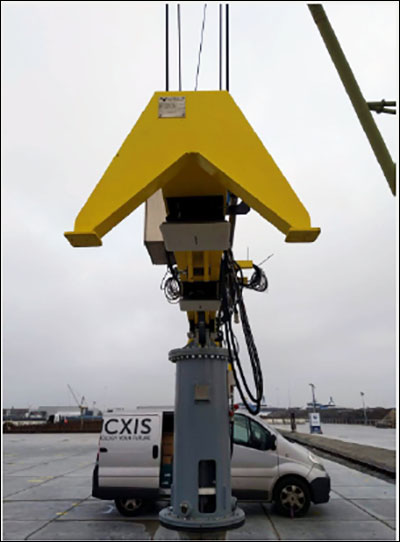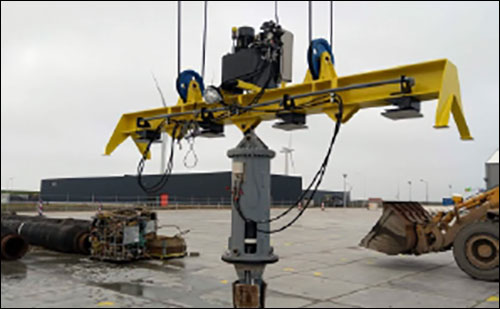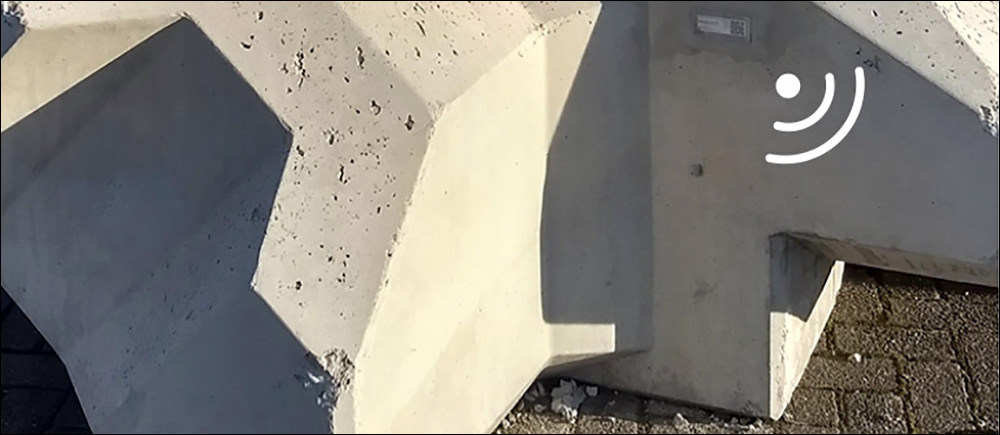Mar 09, 2021A 20-mile dike-reinforcement project in North Holland is leveraging UHF RFID technology to manage each of 75,000 blocks as they are manufactured, stored and then installed to future-proof a 90-year-old retainment structure. The Dutch government's Ministry of Infrastructure and Water Management (Rijkswaterstaat) project, led by the Levvel Consortium, is scheduled for completion in 2022. The RFID-enabled blocks now being installed in the dam are using RFID technology provided b y Aucxis RFID Solutions. The project was launched in late 2018.
The renovation of the Afsluitdijk ("Enclosure Dam" in English) includes a new layer of blocks along 20 miles of the dike's length, while management of the operations and long-term maintenance of those blocks is being accomplished by uniquely identifying each one digitally, from the point of manufacture until the blocks' installation. The solution consists of Aucxis's ATLAS Track & Trace technology to monitor each block constructed for the dike, as well as RFID readers supplied by Impinj, which are deployed at the manufacturing location, in the concrete block-drying area and on cranes that lower the blocks into place at the dam site. Idencia provided the UHF RFID tags embedded in the blocks, as well as data-tracking software.

The Afsluitdijk dike
Aucxis's HERTZ middleware stores the data in the cloud. Levvel can access this information to obtain status updates, and in the future it could be used to locate the positions of blocks that might require repair or replacement. By tracking the blocks, Levvel can manage production and ensure required volumes are being met, while also monitoring when the blocks are cured and ready for installation, when they leave the site, and when and where they are installed in the dike, according to Lauran D'hanis, an Aucxis account manager and business consultant.
Levvel is a construction consortium whose members include Van Oord, BAM PPP and Rebel Valley BV. Its four-year project is intended to future-proof the dike by reinforcing it to boost safety and drainage capacity in a way that is sustainable, effective and attractive. The planners claim the renovated dike will be able to withstand high water and winds from the type of storm that occurs once every 10,000 years.

RFID antennas and readers were installed on a pontoon crane.
The Afsluitdijk, an iconic 32-kilometer-long dam and causeway built in 1932, protects parts of the Netherlands from flooding by the Wadden Sea and Ijsselmeer Bay. After nearly nine decades of use, the dike requires renovation, including reinforcement of its structures as water rises. The work is intended to address climate change-based challenges related not only to rising sea levels, but also to extreme weather. In addition, it is intended to manage excess water flowing into the Ijsselmeer from inland waterways.
To prevent flooding in communities within the region, the dike's capacity needed to be increased so it could drain water to the Wadden Sea. In order to accomplish this goal, the project will include an added protective top layer over the 20-mile section of existing dike, and the team will strengthen the locks, install large pumps and create new storm-surge barriers. The blocks, manufactured at a temporary site in Harlingen, are being produced at a rate of 100 per day using a fully automated process.
To ensure that the blocks (known as XBlocs) are both strong and sustainable, they are designed with less concrete then traditional such blocks—they contain a concrete outer layer—and they thus create lower carbon dioxide emissions. In fact, the consortium estimates a 56 percent emission reduction. The blocks, however, are large, as each weighs 6,500 kilos (14,330 pounds), and they come with rough top layers that allow salt vegetation to grow on them. Once manufactured, each block is stored until it is needed onsite, at which point it is transported by barge and installed via a crane.
Building a tag that could operate well in a wet, outdoor environment proved challenging, D'hanis says. The passive UHF tags not only had to be embedded into the blocks, but they must be watertight and readable. "To ensure this," he adds, "we executed a proof-of-concept first." Additionally, the RFID antennas and readers on the crane need to operate in a climatically harsh environment. The company installed Impinj's four-port R420 readers for this purpose.
Levell embeds the passive UHF tags at the point of manufacture while the blocks are being formed, using a ruggedized inlay optimized by Aucxis. The unique ID number encoded on each tag is stored and linked to a particular block ID in the HERTZ software, along with data regarding the material in the block. The blocks are interrogated by the fixed reader at the point at which they were manufactured, and again in the storage area after they have been cured and are ready for installation. They are then loaded onto barges to be transported to the worksite.

The antennas and readers read information about each concrete block.
At the dike, the blocks are installed using a De Titaan crane on a pontoon, and around 35 meters (115 feet) of blocks are added daily. The crane is equipped with a GPS unit from Levvel that captures its positions. The crane reader interrogates tag IDs as each block is installed, and it identifies not only the specific block but also the GPS position of the crane as that action took place. The HERTZ middleware links its unique ID with that location, enabling the system to permanently store data indicating where each block is installed.
The data collected is intended not only to provide visibility into the production and installation of the dike wall blocks during construction, D'hanis says, but also to aid in future maintenance. "In case a problem occurs with them in the future," he explains, "Levvel will know exactly where to find which blocks, thanks to GPS coordinates." The value of RFID, he says, is the digital capture of information about where each block is built into the dike, along with what it consists of. "It gives them a full inventory of where each block was positioned, containing all concrete information and parameters that were collected during the production flow."
This information can aid in subsequent maintenance, D'hanis says. For instance, if a particular type of block is found to require replacement, operators can replace all such blocks. In the meantime, as block production and onsite placement is carried out, Levvel can track the status of every block without requiring manual counting. Once the project is complete, he says, the company intends to tear down the block factory and rebuild it at other locations for later construction projects.

A concrete block with an embedded RFID tag containing product data

